![]()
![]()
![]()
Use LEFT and RIGHT arrow keys to navigate between flashcards;
Use UP and DOWN arrow keys to flip the card;
H to show hint;
A reads text to speech;
36 Cards in this Set
- Front
- Back
|
slope of the secant line
|
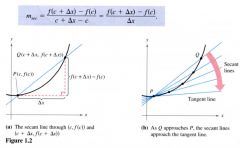
|
|
|
The limit of (f):
|

|
|
|
common types of behavior associated with Nonexisitance of a Limit:
|
1. f(x) approaches a different number form the right side of c than it approaches from the left side
2. f(x) increases or decreases without bound as x approaches c. 3. f(x) oscillates between two fixed values as x approaches c. |
|
|
Definition of Limit:
|

|
|

|
b
|
|

|
c
|
|

|

|
|

|
bL
|
|

|

|
|

|
LK
|
|
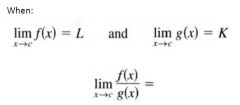
|

|
|
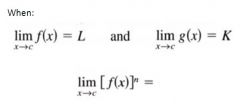
|

|
|

If p is a polynomial function and c is a real number, then
|
p(c)
|
|

If r is a rational function given by r(x) = p(x)/q(x) and c is a real number such that a(c) can not equal 0, then
|

|
|

Let n be a positive integer. The following limit is valid for all c if n is odd, and is valid for c>0 if n is even.
|

|
|

If f and g are functions such that the limit of g(x)= L as x approaches c and the limit of f(x) = f(L) as x approaches L, then
|

|
|

|
sin c
|
|

|
cos c
|
|

|
tan c
|
|

|
sec c
|
|

|
csc c
|
|

functions that agree at all but one point
let c be a real number and let f(x) = g(x) for all x can not equal c in an open interval containing c. if the limit of g(x) as x approaches c exists, then the limit of c(x) also exisist and |

|
|
|
strategy for finding limits
|

|
|
|
The squeeze theorem
|

|
|

|
1
|
|

|
0
|
|
|
Definition of Continuity
|

|
|
|
The Existence of a limit
|

let f be a function and let c and L be real numbers. The limit of f(x) as x approaches c is L if and only if
|
|
|
Definition of Continuity on a closed interval
|

|
|
|
The Properties of Continuity
|
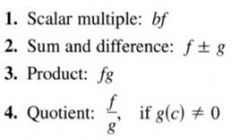
if b is a real number aned f and g are continuous at x=c, then the following functions are also continouous at c.
|
|
|
Continuity of a Composite function
|

|
|
|
The Intermediate Value Theorem
|
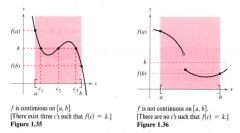
If f is continuous on the colsed interval [a,b] and k is any number between f(a) and f(b), then there is at least one number c in [a,b] such that f(c) = k
|
|
|
Definition of Infinite Limits
|
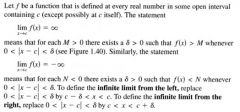
|
|
|
Definition of Vertical Asymptote:
|
If f(x) approaches infinity (or negative infinity) as x approaches c from the right or the left, then the line x = c is a vertical asymptote of the graph of f.
|
|
|
Vertical asymptotes:
|
let f and g be continuous on an open interval containing c. If f(c) does not equal 0, g(c) does not equal 0, and there exists an open interval containing c such that g(x) does not equal 0 for all x does not equal c in the interval, then the graph of the function given by
h(x) = f(x) / g(x) has a vertical asymptote at x = c |
|
|
Properties of Infinite Limits
|
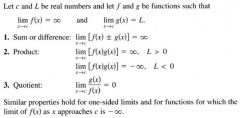
|

